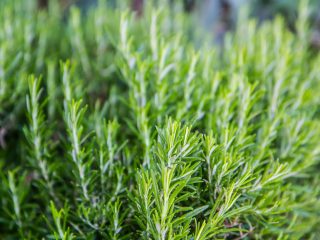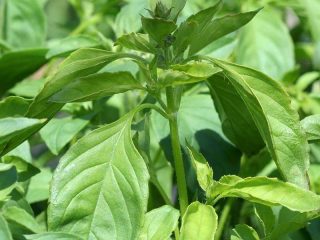Content
Rosemary (photo of the plant is presented below) is an evergreen shrub belonging to the Lamiaceae family. Brought to Russia from the Mediterranean, where it is found in natural conditions. It is widely used as a seasoning in cooking. The plant has healing properties and is therefore used in folk medicine. Often seedlings are used in landscape design.
What does rosemary look like?
Reaches a height of 1.8 m. The flowers are blue-violet in color, rarely white. The flowers are small, collected in dense inflorescences. Flowering ends by mid-summer. After this, grayish-brown nuts are formed, inside of which there are seeds. The grass has a dense woody stem, needle-shaped leaves with a leathery structure. The leaves are located tightly to each other. The color of the stem varies from light brown to gray. The plant produces a camphor aroma reminiscent of sea freshness. The branches are tetrahedral, elongated. The root system is well developed, reaching three meters.
Types and varieties of rosemary
According to the description, the rosemary plant prefers warm, dry climates. With excess moisture it dies and develops poorly. It has two main types (prostrate and ordinary) and many varieties. The main types and popular varieties are described below.
Rosemary officinalis (common)
The most famous and widespread type. The founder of all varieties of shrubs. It has a well-developed root system and dark gray woody shoots. The leaves are leathery and reach 3.5 cm in length. The inflorescences of common rosemary are densely located next to each other. They have a light blue tint. This type of herb is widely used in medicine and cooking. It has a choleretic effect, improves the functioning of the gastrointestinal tract, and is effective for diseases of the upper respiratory tract.
Rosemary prostrate
An ornamental plant is often planted in gardens to decorate the landscape. The grass reaches a height of no more than 75 cm. The branches of the bush grow, and the rosemary takes the shape of a ball. If it is planted along a fence, the bush will branch and overgrow the support, thus forming “hedges”. The flowers are blue or bright purple. This variety is used in cooking because the herb has a pleasant smell. The bushes do not take root well in cold climates. For the winter they are covered or transplanted into a greenhouse.
Rosemary Crimean
This variety appeared in Crimea around the 19th century. Initially, it was grown in the Nikitsky Garden, located on the Crimean peninsula. The flowering period begins in February. Crimean rosemary reaches a height of one meter. The needle-shaped leaves are green, have a grayish tint and a leathery texture. Has a pleasant smell.Bushes can be found on rocky slopes; they are often used to decorate borders and ridges. This species is also grown on plantations for medicinal purposes. It does not survive the cold well; for the winter the seedlings are covered or transplanted into a greenhouse.
Rosemary Tenderness
This is one of the popular plant varieties. It reaches a height of 1 meter. The flowers are light blue in color. The leaves, with a leathery structure, change color depending on the growing season. At the beginning of flowering, the leaves are green, and towards the end they have a gray-green color. This is a perennial plant. The shrubs are thermophilic and cannot easily tolerate sudden drops in air temperature. They take root well in countries with warm climates. In northern countries, rosemary is grown indoors.
Rosemary Dewdrop
Rosemary Dewdrop is a perennial plant widely used in cooking. It reaches a height of 40–60 cm. The leaves have an elongated shape, reminiscent of spruce needles. They contain a large amount of essential oils. The leaves are dark green in color and are densely spaced on the stem. The shrub exudes a pleasant aroma reminiscent of a mixture of sea and lavender. The flowers are bluish-violet, fragrant. The plant does not easily tolerate low temperatures, so when grown in open ground, for the winter the bush is moved indoors with a low but positive temperature or covered.
How does rosemary grow?
The shrub prefers soils rich in humus and well aerated. It is difficult to tolerate high moisture. In southern countries it grows on rocky slopes. Tolerates summer heat well and loves illuminated areas. The leaves have a leathery structure, are dense and accumulate moisture well, due to which the plant easily tolerates drought.
To plant rosemary in open ground, you should choose a southern area with good lighting. If the plant has overwintered in a cool room, it should be taken outside for planting only after the threat of return frosts has passed. Before planting, the plant is given several days to acclimatize, only after that it is planted in open ground.
How long does rosemary grow?
It is a perennial evergreen, a plant that lives for more than twenty years. Rosemary can be grown as a houseplant or used as outdoor decor.
To make the plant pleasing to the eye, it is necessary to fertilize it with mineral fertilizers. Bushes are planted at a distance of 50–60 cm from each other.
Where does rosemary grow?
As a wild plant, rosemary is widespread in Greece, the Mediterranean, South Africa, Spain, Portugal, Cyprus and Transcaucasia. It can often be found in the mountains. Artificial plantations are being erected in the Crimea, subtropics and tropics. Cultivated rosemary grows in the southern part of Russia and is not found in the wild. In 1813, it was first cultivated in the Crimea in the Nikitsky Garden. Since then it has been grown as a cultivated plant.
The use of rosemary in landscape design
Shrubs to decorate the landscape are planted in groups or combined with other species and varieties. In southern countries they are planted along the fence, thus making fences. Species with creeping shoots are planted next to fences, supporting walls or steps. The bushes beautifully wrap around the fence, and during the flowering period they delight with their scent.They should not be watered more than once a week, as the bushes do not tolerate moisture well and may die.
In Russia, plants are grown in pots. In the warm season they are taken out into the garden. Pots are selected to match the garden landscape. Most often they are placed next to the summer kitchen and combined with other herbs. Shrubs go well with thyme, oregano, lavender, sage, juniper, and speedwell. Eremurus looks harmonious next to it.
The bushes tolerate pruning well, and after pruning they become denser. They are used in mixed border plantings, along the edge of mixborders, and in container gardening.
Conclusion
The beauty of the rosemary herb (photo of the plant below) was appreciated by landscape designers. It is widely used to decorate flower beds, borders, and hedges. In addition, the herb is used as a seasoning and as a medicine in folk and traditional medicine. The plant has many species and varieties; they are large, more than 1 meter in height, and small, about 40 centimeters. This herb is also grown at home and used as a fresh spice for dishes.















